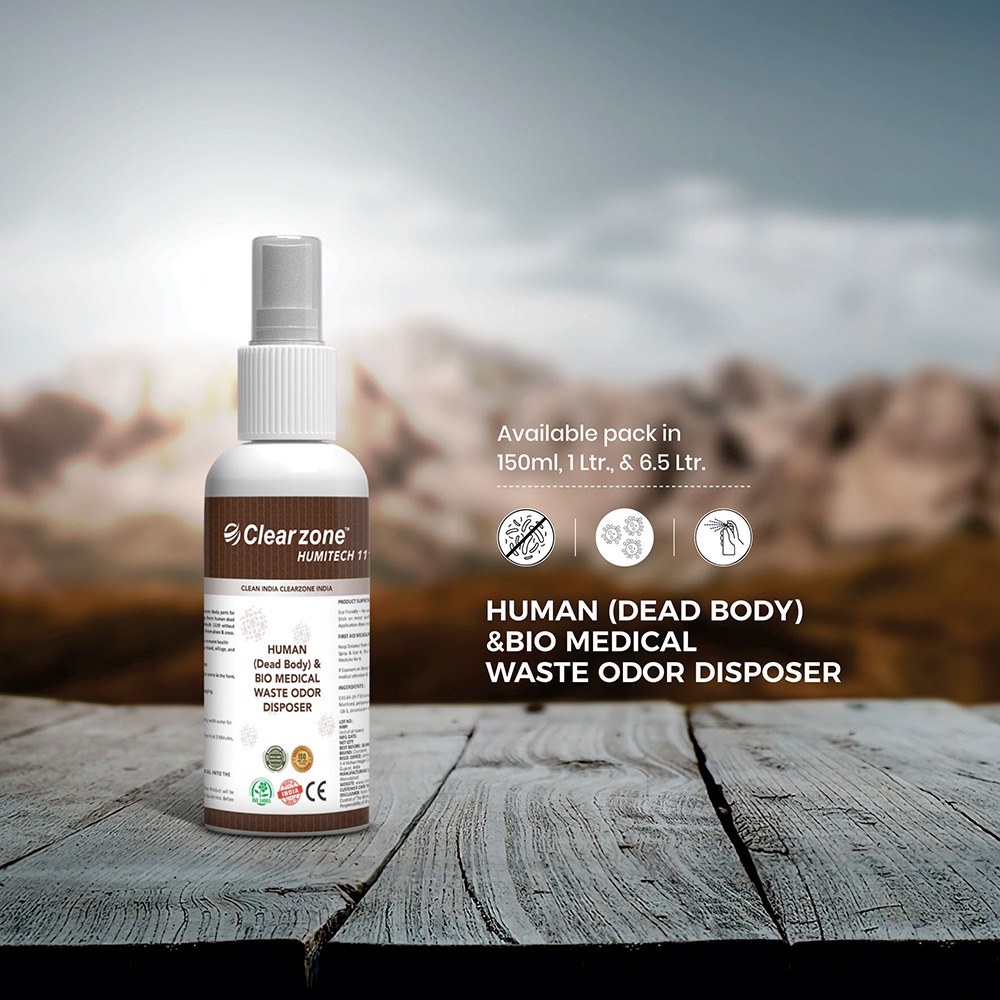Bio Medical waste Odor Disposer Manufacturer in India
HUMITECH 1119 Odor Disposer, particularly from decaying bodies and biomedical waste, can be not only distressing but also harmful to health and the environment. Whether in government health departments, highways, or residential areas, managing these foul smells is crucial for maintaining public safety and hygiene. HUMITECH 1119 Human (Dead Body) & Bio Medical Waste Odor Disposer is designed to offer a reliable and comprehensive solution to tackle these challenges. This product is effective at neutralizing even the most persistent odors, ensuring a cleaner and safer environment. In this blog, we’ll explore how HUMITECH 1119 Human (Dead Body) & Bio Medical Waste Odor Disposer works, its key features, and why it is essential for odor management.
Understanding the Need for HUMITECH 1119
Managing the odor from decomposing human bodies and biomedical waste is more than just an issue of comfort—it’s a public health necessity. Let’s break down why HUMITECH 1119 Human (Dead Body) & Bio Medical Waste Odor Disposer is crucial:
- Addressing Unpleasant Odors: The decomposition of organic matter, particularly dead bodies and medical waste, releases harmful gases and bacteria that cause unpleasant odors. These odors can quickly become overwhelming, especially in catastrophic events where multiple deaths or large amounts of waste need to be managed. HUMITECH 1119 Human (Dead Body) & Bio Medical Waste Odor Disposer is specifically formulated to absorb and neutralize these foul smells, ensuring a cleaner and more pleasant environment.
- Applicable in Multiple Scenarios: This product is highly versatile and can be used in a variety of situations, including:
- Government health departments: Where bodies are stored or disposed of.
- National highways and city roads: Where accidents might lead to the need for quick odor management.
- Village and residential areas: Where there may be natural deaths or the need to manage biomedical waste.
- Catastrophic events: Large-scale disasters where rapid odor control is vital for public safety.
- Hygiene and Health Concerns: Apart from the unpleasantness, the odor from decaying matter can be a health hazard. Bacteria, pathogens, and other harmful microorganisms are often present in decomposing bodies and waste. HUMITECH 1119 Human (Dead Body) & Bio Medical Waste Odor Disposer not only neutralizes bad smells but also works to kill harmful bacteria, promoting a cleaner and safer environment.

Key Features of HUMITECH 1119
What makes HUMITECH 1119 Human (Dead Body) & Bio Medical Waste Odor Disposer stand out? Here are its key features:
- Powerful Odor Absorption: This product doesn’t merely mask the smell; it absorbs the molecules that cause foul odors. The formulation penetrates deep into the affected areas, neutralizing lingering smells effectively and permanently. Even after the source of the odor has been removed, HUMITECH 1119 Human (Dead Body) & Bio Medical Waste Odor Disposer continues to provide a fresh, odorless environment.
- Kills Harmful Bacteria and Germs: In addition to managing the odor, this product works to kill 99.99% of bacteria and germs in the area, such as Escherichia coli and Salmonella. This makes HUMITECH 1119 Human (Dead Body) & Bio Medical Waste Odor Disposer a powerful solution for maintaining hygiene, especially in sensitive areas like hospitals, mortuaries, and accident sites.
- Long-lasting Effects: A single application of HUMITECH 1119 Human (Dead Body) & Bio Medical Waste Odor Disposer provides long-lasting odor control. It keeps working for an extended period, ensuring that the area remains fresh and odor-free long after the initial treatment.
- Environmentally Friendly: Many odor control solutions contain harmful chemicals that can be damaging to the environment. However, HUMITECH 1119 Human (Dead Body) & Bio Medical Waste Odor Disposer is designed to be eco-friendly, offering a safe and sustainable solution without harming the environment.
How to Use HUMITECH 1119
Applying HUMITECH 1119 Human (Dead Body) & Bio Medical Waste Odor Disposer is straightforward and effective. Here’s how:
- Shake Well Before Use: Ensure that the contents of the product are well mixed before application.
- Use the Spray Pump for Easy Application: The product comes with a convenient nozzle or spray pump that allows for easy and precise application to the required area. Direct the spray towards the area where the odor is most intense, ensuring uniform coverage.
- Multiple Applications for Severe Odors: In cases where the decay smell is particularly strong, apply the product multiple times, or at hourly intervals. This ensures that the odor is thoroughly neutralized.
- Maintains Cleanliness: After applying the product, not only will the bad smell be eliminated, but the area will also be sanitized. HUMITECH 1119 Human (Dead Body) & Bio Medical Waste Odor Disposer kills germs and bacteria, making the environment safer for everyone.
Why Choose HUMITECH 1119?
There are several reasons why HUMITECH 1119 Human (Dead Body) & Bio Medical Waste Odor Disposer is the best choice for managing unpleasant odors:
- Reliable for Emergency Situations: In times of disaster or when dealing with decaying matter, it’s important to have a reliable solution on hand. HUMITECH 1119 Human (Dead Body) & Bio Medical Waste Odor Disposer has been proven to work effectively in emergency situations, ensuring that odor management is one less problem to worry about.
- Promotes Health and Safety: By eliminating odors and bacteria, this product helps create a safer environment for both workers and the general public. Whether it’s used in hospitals, highways, or residential areas, HUMITECH 1119 Human (Dead Body) & Bio Medical Waste Odor Disposer ensures that the air is cleaner and safer to breathe.
- Simple and Easy to Use: Despite its powerful effects, HUMITECH 1119 Human (Dead Body) & Bio Medical Waste Odor Disposer is extremely easy to use. With its convenient spray application, anyone can use it to manage odors without the need for special training or equipment.
- Safe for the Environment: Using environmentally-friendly solutions is becoming increasingly important, especially when managing sensitive situations like decaying bodies and biomedical waste. HUMITECH 1119 Human (Dead Body) & Bio Medical Waste Odor Disposer is designed to be safe for the environment, making it the responsible choice for odor control.
Conclusion
In summary, HUMITECH 1119 Human (Dead Body) & Bio Medical Waste Odor Disposer is an essential tool for managing the unpleasant odors associated with decaying bodies and biomedical waste. It offers powerful odor absorption, eliminates harmful bacteria, and is suitable for use in a wide range of scenarios, from government health departments to residential areas. By using HUMITECH 1119 Human (Dead Body) & Bio Medical Waste Odor Disposer, you can ensure a cleaner, safer environment for everyone.
Invest in HUMITECH 1119 Human (Dead Body) & Bio Medical Waste Odor Disposer today and experience the peace of mind that comes with effective odor control and improved hygiene!
For more updates and detailed information on our products, subscribe to our YouTube channel where we regularly share product tips, updates, and innovations.
🔗 Visit our website: www.clearzone.in
📞 Contact us: +91 6355767644
📧 Email: clearzone.in@gmail.com
Subscribe to Our YouTube Channel 🛎️
Clearzone YouTube




